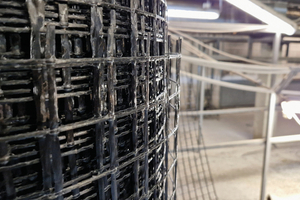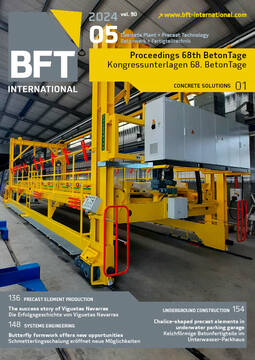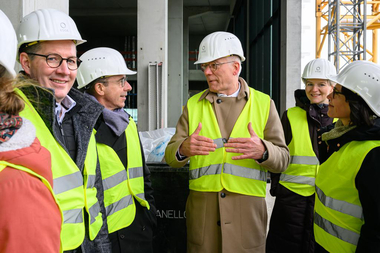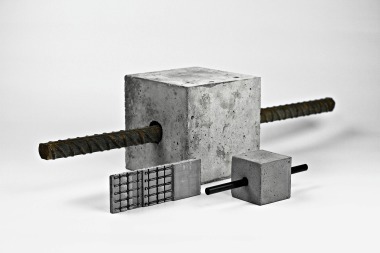Thoughts – words – (in)action?Establishing carbon concrete from a mouthpiece to a craft
Rock and pop star David Bowie once said: “If you play the same song every day, you have stopped getting better.”
When applying this quote to the present types of construction using reinforced concrete as a composite material, the following well-known sentence can be derived: “We have always done it this way.”
In view of the development of a mega-trend such as carbon concrete, what are the actual obstacles in the construction industry that prevent this technology from being established as a construction method on a large scale, not only to improve structures but also to advance the improvement of the parties involved in construction?
Carbon concrete is an innovative construction material consisting of concrete and carbon fibers. It is characterized by high strength, durability and environmental friendliness.
Carbon concrete is an important megatrend in the 21st century. It is a resource-efficient construction material representing a sustainable and environmentally friendly alternative to conventional concrete.
Carbon concrete is less heavy and more stable than conventional concrete, has a better carbon footprint and is therefore ideal for use in the construction industry.
Carbon concrete is already used in various applications such as bridge construction, building construction and tunnel construction,
and in structures such as multi-story car parks, but usually with an approval on a case-to-case basis. However, there are many other areas of application that can be developed in the future.
Carbon concrete thus offers advantages that are numerous and quite obvious compared to conventional concrete. In addition, carbon concrete can be produced in various shapes and sizes, making it an equally versatile construction material.
Carbon concrete has a strong position both in terms of arguments and, following from that, in terms of technology compared to other construction materials. It is an innovative construction material used more and more frequently in the construction industry.
In conclusion, carbon concrete is a fundamental, and certainly the most important, megatrend of the 21st century. It is a resource-efficient construction material representing a sustainable and environmentally friendly alternative to conventional concrete. Carbon concrete has many advantages over conventional concrete, and a strong technological position in comparison with other construction materials. Nevertheless, carbon concrete is viewed with skepticism, which relates to structures that do not yet have a proven long-term track record. How could it be possible, today, to provide empirical values of 50, 70 or 100 years? Another aspect of general skepticism is the blanket assumption of high pricing and, probably the most important question, how a carbon concrete structure will be demolished at the end of its useful life and processed into its individual components for reuse.
Skepticism and defensive behavior towards innovations are natural reactions that can occur in numerous situations. Skepticism is a critical attitude towards new ideas or concepts. It can contribute to testing new ideas for their strengths and weaknesses. Defensive behavior, on the other hand, is a negative reaction to new ideas or concepts. It can result in new ideas being rejected without having been sufficiently tested.
The causes of skepticism and defensive behavior can be manifold. Some people are afraid of change and prefer to hold on to familiar things. Others have had negative experiences with new ideas and are therefore skeptical about new concepts. There are also people who simply do not want to leave their comfort zone or to face new challenges.
Skepticism and defensive behavior can have a wide range of different effects. In some cases, they can lead to the rejection of new ideas that could actually be very helpful. In other cases, they can contribute to testing, and thus improving, new ideas for their strengths and weaknesses.
There are various strategies for overcoming skepticism and defensive behavior. One option is to emphasize the benefits of new ideas and concepts and to demonstrate how they can contribute to solving existing problems. Another option is to take the concerns of skeptics seriously and to respond to their questions and concerns. It can also be helpful to present examples of the successful application of new ideas.
In conclusion, skepticism and defensive behavior towards innovations are natural reactions that can occur in numerous situations. However, there are various strategies to overcome these reactions and successfully implement new ideas and concepts. Strategic marketing approaches are sometimes the solution to eliminate skepticism.
Strategic marketing approaches offering effective “pro carbon concrete” arguments can address the advantages of carbon concrete over conventional concrete. It is important to communicate the benefits of carbon concrete clearly and concisely to convince potential customers. The most important advantages of carbon concrete include:
Lightweight: carbon concrete is less heavy than conventional concrete, which facilitates transportation and placement.
Structural stability: carbon concrete is more structurally stable than conventional concrete and can therefore support higher loads.
Durability: carbon concrete is more durable than conventional concrete and can last for decades or even centuries.
Environmental friendliness: carbon concrete has a better carbon footprint than standard concrete and is therefore more environmentally friendly.
It is also important to emphasize the range of applications of carbon concrete and to show how it can be used in different sectors.
The most important applications of carbon concrete include:
Bridge construction: carbon concrete is already used in many bridges because it is less heavy and more structurally stable than standard concrete.
Building construction: carbon concrete can also be used in building construction to erect buildings of lower weight that are more structurally stable than conventional buildings.
Tunnel construction: carbon concrete can also be used in tunnel construction to build tunnels that are more durable and more structurally stable than conventional tunnel structures.
Tank construction: for example, drinking water tanks with the relevant additional technical approvals in direct contact with Germany’s number one food resource
General concrete maintenance and concrete rehabilitation.
Strategic marketing approaches offering effective “pro carbon concrete” arguments can address these advantages and demonstrate the potential use of carbon concrete in different sectors. This requires intrinsic and extrinsic goals and incentives for such a megatrend on the part of those involved in construction.
Intrinsic and extrinsic incentives and goals are major factors that influence people’s behavior. Intrinsic incentives arise from the individual personality, such as job satisfaction and research on the subject matter in hand. Extrinsic incentives, on the other hand, bring forth actions that result from external incentives such as rewards, subsidies, awards and prestige.
Megatrends are long-term developments influencing both society and the economy. Carbon concrete is an example of a megatrend due to its pioneering technology. Megatrends often have far-reaching effects on society and the economy.
Intrinsic and extrinsic incentives and goals therefore play a major role in megatrends. Intrinsic incentives can contribute to people taking an interest in a particular topic and getting involved. Extrinsic incentives, on the other hand, can also contribute to people getting involved in a particular topic, for example, because they expect a reward.
Another example of an intrinsic incentive in a megatrend could be that a person is interested in the environment and is therefore dedicated to climate protection. Another example of an extrinsic incentive could be that a person is dedicated to climate protection because he or she expects a financial reward.
Megatrends have always contributed to creating many jobs and new business models. Just think of electricity and the steam engine.
In conclusion, the carbon concrete megatrend is a long-term development that will influence society and the economy. That is why it is basically a question of getting carbon concrete into people’s heads so that it is translated into action.
Positioning carbon concrete with those involved in construction can be achieved in various ways. One possibility is to offer training courses and workshops for architects, engineers and construction contractors to inform them about the advantages of carbon concrete.
It is also important that the general public is informed about the benefits of carbon concrete in order to raise awareness of this innovative construction material.
Another important factor for positioning carbon concrete is collaboration between the parties involved in construction. It is important that all parties involved work together to maximize the benefits of carbon concrete and promote its use in construction. Close cooperation between architects, engineers and construction contractors can help to ensure that carbon concrete is used in various areas of application. It is imperative to involve decision makers at the municipal level, as well as at state and federal levels.
Positioning carbon concrete with those involved in construction is an important factor in spreading these material. It is important to offer training courses, exhibitions and workshops to communicate the advantages of carbon concrete and promote collaboration between the parties involved in construction. This is the only way for carbon concrete to develop its full potential in construction engineering.
The subject of carbon concrete is dependent on addressing the conscious or subconscious perception in the construction industry, politics and society at large: an approach shifting from the fundamental technology and design principles to addressing the question of how ready these groups currently are to play an active part in the future of construction in view of the changes brought about by this megatrend. The great common goal of implementing a vision will not emerge until these groups allow carbon concrete to play a central role in construction and the German Institute for Structural Engineering (DIBt) in Berlin introduces this megatrend as state of the art and engineering practice and as a composite construction material and construction method via the federal states so that they include carbon concrete in the state building codes. In this context, it is also necessary to create a link to the EU and the Commission responsible for it.
So when thoughts about this megatrend are put into words, the only thing that matters is whether these thoughts and words are translated into action. If this does not happen, inaction will not allow this megatrend to take hold and will sideline it. It is important for us to be aware of our thoughts on carbon concrete and how they will influence technological progress in construction engineering. If we focus on positive thoughts about this megatrend, we can positively influence this technology and its marketing. Let us therefore pay attention to our positive thoughts wisely and prudently, as they will become words. If we pay attention to our words in the form of reasonable, plausible, knowledgeable and emotional arguments, they will translate into action. Actions for implementing a fascinating technology. A megatrend that will be followed by action. A vision to realize the future of construction with carbon concrete. Let us always keep our eye on the goal. Respice finem.







